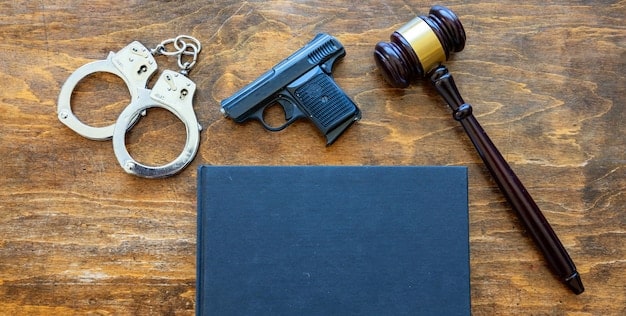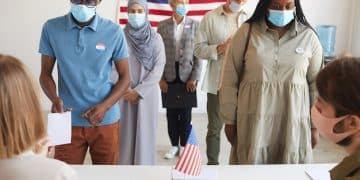Analyzing the Impact of Updated Gun Control Legislation on Public Safety

Analyzing the impact of updated gun control legislation on public safety involves examining statistical data, research studies, and societal trends to determine its effectiveness in reducing gun violence and enhancing community well-being.
The debate surrounding gun control continues to be a contentious issue in the United States. Analyzing the impact of the updated gun control legislation on public safety requires a comprehensive evaluation of its intended effects, potential consequences, and alignment with constitutional rights.
Understanding the Scope of Gun Control Legislation
Gun control legislation encompasses a variety of laws and regulations aimed at restricting access to firearms and reducing gun violence. These measures can range from background checks and waiting periods to bans on certain types of weapons and restrictions on magazine capacity.
Understanding the scope of such legislation is crucial for evaluating its potential impact on public safety and individual liberties. Different types of gun control laws may have varying effects on crime rates, accidental shootings, and self-defense capabilities.
Types of Gun Control Measures
Gun control measures typically fall into several categories, each designed to address specific aspects of gun violence. These categories include:
- Background Checks: Requiring individuals to undergo background checks before purchasing firearms to prevent convicted felons, domestic abusers, and those with mental health issues from acquiring guns.
- Waiting Periods: Mandating a waiting period between the purchase and possession of a firearm to reduce impulsive acts of violence.
- Assault Weapons Bans: Prohibiting the sale and possession of certain types of semi-automatic rifles and high-capacity magazines.
- Red Flag Laws: Allowing law enforcement or family members to petition a court to temporarily remove firearms from individuals deemed a danger to themselves or others.
These measures can affect different populations and communities in various ways, influencing the overall effectiveness of gun control efforts.
In conclusion, a thorough understanding of the different types of gun control measures is crucial for evaluating their potential impact on public safety, requiring a nuanced analysis of their effects on various aspects of gun violence and individual liberties.
Historical Overview of Gun Control in the U.S.
Gun control legislation in the United States has a long and complex history, dating back to the early 20th century. Over time, different laws and regulations have been enacted at both the federal and state levels in response to changing societal concerns and patterns of gun violence.
Examining this historical context provides valuable insights into the evolution of gun control policies and their effectiveness in addressing public safety challenges. It also highlights the ongoing debates and controversies surrounding gun rights and regulations.

Key Legislation and Supreme Court Cases
Several landmark pieces of legislation and Supreme Court cases have shaped the landscape of gun control in the U.S. These include:
- National Firearms Act (1934): Imposed taxes and registration requirements on certain types of firearms, such as machine guns and short-barreled rifles.
- Gun Control Act (1968): Established federal licensing requirements for firearms dealers and prohibited the sale of firearms to certain individuals, such as convicted felons and those with mental health issues.
- Brady Handgun Violence Prevention Act (1993): Mandated federal background checks for firearm purchases.
- District of Columbia v. Heller (2008): Affirmed the individual right to bear arms for self-defense in the home.
Each of these legislative and judicial developments has contributed to the ongoing debate over gun rights and regulations, influencing the direction of future gun control efforts.
By examining these historical precedents, policymakers and citizens can gain a deeper understanding of the legal and political context surrounding gun control in the U.S., informing discussions about future policy changes and their potential impacts on public safety.
Analyzing the Impact of Updated Legislation on Gun Violence
One of the key goals of gun control legislation is to reduce gun violence, including homicides, suicides, and accidental shootings. Analyzing the impact of updated gun control legislation on public safety involves examining statistical data and research studies to assess its effectiveness in achieving this goal.
It’s crucial to consider various factors, such as changes in crime rates, patterns of gun ownership, and access to mental health services, to gain a comprehensive understanding of the legislation’s effects on gun violence.

Statistical Data and Research Findings
Numerous studies have examined the relationship between gun control legislation and gun violence rates. Some studies have found a correlation between stricter gun control laws and lower rates of gun violence, while others have found no significant impact.
It’s important to critically evaluate the methodology and findings of these studies, considering factors such as sample size, data sources, and potential confounding variables, to draw informed conclusions about the effectiveness of gun control legislation.
A comprehensive analysis of statistical data and research findings is essential for evaluating the impact of updated gun control legislation on gun violence, providing valuable insights for policymakers and citizens alike. This data informs discussions about the effectiveness of different gun control measures and their potential consequences for public safety.
Public Opinion and Political Landscape
Public opinion plays a significant role in shaping gun control policy in the United States. Political ideologies, cultural norms, and personal experiences all influence individuals’ views on gun rights and regulations.
Understanding the public opinion and political landscape surrounding gun control is crucial for navigating the complex debates and controversies that arise when drafting and implementing gun control legislation.
The Role of Advocacy Groups and Political Parties
Advocacy groups and political parties on both sides of the gun control debate actively work to influence public opinion and policy decisions. These groups engage in various activities, such as lobbying, grassroots organizing, and public education campaigns.
- Gun Rights Advocates: Groups such as the National Rifle Association (NRA) advocate for the protection of Second Amendment rights and oppose many forms of gun control legislation.
- Gun Control Advocates: Organizations like Everytown for Gun Safety and Giffords Law Center advocate for stricter gun control laws to reduce gun violence.
- Political Parties: The Democratic and Republican parties often have differing stances on gun control, reflecting broader ideological differences about the role of government and individual liberties.
The interplay between public opinion, advocacy groups, and political parties shapes the trajectory of gun control policy in the U.S., influencing the types of laws that are enacted and their enforcement.
By understanding the dynamics between these factors, policymakers and citizens can better engage in constructive dialogue about gun control and work towards solutions that address public safety concerns while respecting constitutional rights.
Economic and Social Factors
Economic and social factors can also play a role in shaping the impact of gun control legislation on public safety. Poverty, unemployment, and lack of access to education and healthcare can contribute to higher rates of crime and violence, including gun violence.
Addressing these underlying social and economic issues may be an important complement to gun control efforts in reducing gun violence and enhancing community well-being. By considering the interplay between economic and social factors and gun control legislation, policymakers can develop more comprehensive strategies for promoting public safety.
Socioeconomic Disparities and Gun Violence
Studies have shown that certain communities and demographic groups experience disproportionately high rates of gun violence, often linked to socioeconomic disparities. These disparities may include:
- Poverty: Higher rates of poverty are often associated with higher rates of crime, including gun violence.
- Unemployment: Lack of job opportunities can lead to frustration and desperation, increasing the risk of involvement in criminal activity.
- Education: Limited access to quality education can reduce opportunities for upward mobility, perpetuating cycles of poverty and violence.
- Healthcare: Inadequate access to mental health services can exacerbate mental health issues, increasing the risk of suicide and other forms of violence.
Addressing these socioeconomic disparities is essential for reducing gun violence and promoting safer, healthier communities.
By investing in programs that address poverty, unemployment, education, and healthcare, policymakers can create opportunities for individuals and communities to thrive, reducing the risk factors associated with gun violence and enhancing the overall effectiveness of gun control efforts.
Potential Unintended Consequences
When evaluating the impact of gun control legislation, it is important to consider potential unintended consequences. While the intent of these laws is often to reduce gun violence and enhance public safety, they may also have unintended effects on law-abiding citizens, gun owners, and communities.
These unintended consequences could include restrictions on self-defense capabilities, increased black market activity, or disproportionate impacts on certain demographic groups. Evaluating potential unintended consequences is essential for fine-tuning gun control policies and ensuring that they achieve their intended goals without causing undue harm.
Impact on Law-Abiding Gun Owners
One potential unintended consequence of gun control legislation is that it may restrict the ability of law-abiding citizens to exercise their Second Amendment rights. For example:
- Stricter background checks may delay or deny firearm purchases for legitimate buyers.
- Restrictions on certain types of firearms may limit self-defense options.
- Increased regulations may make it more difficult for gun owners to comply with the law.
Balancing the rights of law-abiding gun owners with the need to reduce gun violence is a central challenge in the gun control debate.
Understanding the potential unintended consequences of gun control legislation is essential for ensuring that these laws are carefully crafted and implemented in a way that minimizes harm to law-abiding citizens and maximizes their effectiveness in reducing gun violence.
| Key Point | Brief Description |
|---|---|
| ⚖️ Scope of Legislation | Various laws aimed at restricting firearm access and reducing gun violence. |
| 📜 Historical Context | Gun control laws in the US have evolved over time, influenced by key legislation and court cases. |
| 📊 Impact on Violence | Statistical analysis to determine the effectiveness of gun control in reducing gun violence. |
| 🗣️ Public Opinion | Public views and advocacy groups shape gun control policies and debates. |
Frequently Asked Questions
Main types include background checks, waiting periods, assault weapons bans, and red flag laws, each targeting different aspects of gun access and safety.
Background checks aim to prevent firearms from reaching individuals with criminal records, mental health issues, or domestic violence histories.
Proponents say they reduce mass shootings; opponents argue they infringe on Second Amendment rights and don’t significantly impact crime.
Red flag laws allow temporary removal of guns from those deemed a danger, but their effectiveness is still being studied and debated.
Poverty, unemployment, and lack of education contribute to higher crime rates, including gun violence, highlighting the need for comprehensive solutions.
Conclusion
Analyzing the impact of updated gun control legislation on public safety is a complex and multifaceted endeavor. It requires a careful consideration of statistical data, research findings, public opinion, political dynamics, economic factors, and potential unintended consequences. By engaging in informed and constructive dialogue, policymakers and citizens can work together to develop effective strategies for reducing gun violence and promoting safer, healthier communities while also protecting constitutional rights.





